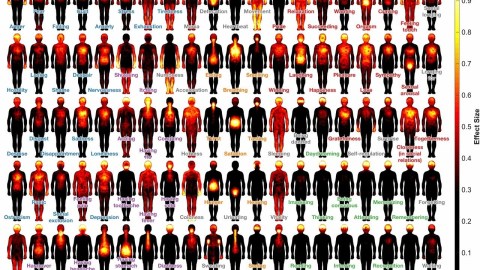A cartography of consciousness – researchers map where subjective feelings are located in the body

Bodily feeling maps. Pixel intensities show regions where each feeling was associated with statistically significant bodily sensations. Image credit: Nummenmaa et. al, 2018.
“How do you feel?” is a simple and commonly asked question that belies the complex nature of our conscious experiences. The feelings and emotions we experience daily consist of bodily sensations, often accompanied by some kind of thought process, yet we still know very little about exactly how these different aspects relate to one another, or about how such experiences are organised in the brain.
Now, reporting their results in PNAS, a team of researchers in Finland, led by neuroscientist Lauri Nummenmaa of the University of Turku, has produced detailed maps of what they call the “human feeling space”, showing how each of dozens of these subjective feelings is associated with a unique set of bodily sensations.
In 2014, Nummenmaa and his colleagues published bodily maps of emotions showing the distinct bodily sensations associated with six basic emotions, such as anger, fear, happiness and sadness, and seven complex emotional states, such as anxiety, love, pride, and shame.
Building on this earlier work, for their new research they recruited 1,026 participants and asked them to complete an online survey designed to assess how they perceive 100 “core” subjective feelings, compiled from the American Psychological Association’s Dictionary of Psychology, ranging from homeostatic states such as hunger and thirst, to emotional states such as anger and pleasure, and cognitive functions such as imagining and remembering.
The participants were shown a list of the 100 core feelings on the computer screen, and asked to drag and drop each one into a box, placing similar feelings close to each other (try it for yourself). They also had to rate each feeling according to how much it is experienced in the body, how much of it is psychological, how pleasant it feels, and how much control they think they have over it.
Their descriptions of the core feelings clustered into five distinct groups, based on similarity: Positive emotions, such as happiness and togetherness; negative emotions, such as fear and shame; thought processes, such as hearing and memorising; homeostatic sensations, such as hunger and thirst; and sensations associated with illness, such as coughing and sneezing.
In another online experiment, Nummenmaa and his colleagues asked the participants to indicate exactly where in the body they felt each state, by colouring in a blank body shape, allowing them to map the bodily sensations associated with the each of the 100 core feelings.
The researchers then pooled these data to create “bodily sensation maps” for each of the core feelings (see image, above). For example, the participants localised the feeling of anger to the head, chest, and hands; feelings of hunger and thirst to the stomach and throat, respectively; and the feelings of ‘being conscious’, imagining, and remembering entirely to the head.
The maps showed that, despite the similarities, each core feeling was associated with a unique set of bodily sensations. For example, participants reported perceiving anger mostly in the head and hands, anxiety mostly in the chest; and sadness in the chest and head. Although similar feelings produced similar body maps, the intensity and precise distribution of bodily sensations associated with each was unique.
That both anger and fear were associated with intense bodily sensations in the head and chest adds to past work showing that both these emotions involve remarkably similar physiological changes to the body, and further explains why we usually have to depend on context to help us interpret the emotional meaning of our sensations.
The new results provide yet more evidence for the emerging idea that the body plays a crucial role in cognitive and emotional processes – something which has, until very recently, been overlooked. “In other words,” says study co-author Riita Hari, “the human mind is strongly embodied.”
Post written by Mo Costandi (@Mocost) for the BPS Research Digest. Mo trained as a developmental neurobiologist and now works as a freelance writer specialising in neuroscience. He wrote the Neurophilosophy blog, hosted by The Guardian, and is the author of 50 Human Brain Ideas You Really Need to Know, and Neuroplasticity.
This article was originally published on BPS Research Digest. Read the original article.





